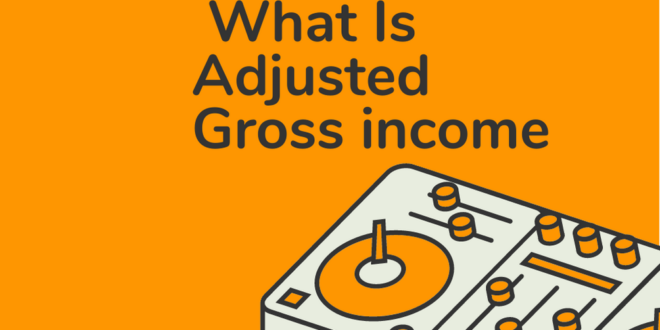What Is Adjusted Gross Income (AGI)?
What is adjusted gross income (AGI)?
Adjusted gross income, or AGI, is your gross income minus certain adjustments. The IRS uses this number as a basis for calculating your taxable income. AGI can also determine which deductions and credits you may qualify for.
How is adjusted gross income (AGI) calculated?
Adjusted gross income is your gross income — which includes wages, dividends, alimony, capital gains, business income, retirement distributions and other income — minus certain payments you’ve made during the year, such as student loan interest or contributions to a traditional individual retirement account or a health savings account.
In general, the formula for calculating AGI is to determine your gross income. This includes income from:
-
Certain business expenses.
-
Deductible HSA contributions.
-
Moving expenses for military.
-
Deductible self-employment taxes.
-
Contributions to retirement plans or health insurance for self-employed people.
-
Penalties on early withdrawals of savings.
Deductible IRA contributions.
-
Deductible tuition and fees.
-
Up to $600 of charitable contributions if you’re taking the standard deduction.
Tax software or your tax preparer will calculate your adjusted gross income as part of the process of preparing your tax return.
Where is adjusted gross income (AGI) on a tax return?
You can find your adjusted gross income right on your IRS Form 1040. On your 2020 federal tax return, your AGI is on line 11 of your Form 1040.
The significance of adjusted gross income (AGI)
Your AGI is often the starting point for calculating your tax bill. From there, you’ll make various adjustments and subtract your allowable deductions to find the amount on which you’ll pay tax: That’s your taxable income. You’ll see the term “adjusted gross income (AGI)” repeated throughout your tax forms.
Your state tax return might also use your federal AGI as a starting point. If you file taxes online, your software will calculate your AGI.
What is your modified adjusted gross income (MAGI)?
According to the IRS, for most taxpayers, modified adjusted gross income, or MAGI, is simply adjusted gross income before subtracting deductible student loan interest.
If you’re filing Form 1040 and itemizing so that you can take certain deductions, you may have to calculate your MAGI. It can also be a baseline for determining the phaseout level of some credits and tax-saving strategies, and sometimes the formula for MAGI can depend on the type of tax benefit it applies to.
-
Federal: $24.95 to $64.95. Free version available for simple returns only.
-
All filers get free live tax advice from a tax pro.
Promotion: Nerd Wallet users get 25% off federal and state filing costs.
-
Federal: $39 to $89. Free version available for simple returns only.
-
TurboTax Live packages offer review with a tax expert.
-
Federal: $29.99 to $84.99. Free version available for simple returns only.
- Online Assist add-on gets you on-demand tax help.
-
Modified Adjusted Gross Income (MAGI)
What Is Modified Adjusted Gross Income (MAGI)?
Your modified adjusted gross income (MAGI) is your adjusted gross income (AGI) after taking into account certain allowable deductions and any tax penalties. It is an important number to understand since it can help with the following:
Key Takeaways
- Modified adjusted gross income (MAGI) adjusts the AGI for certain tax deductions and credits.
- You’ll have to crunch some numbers to find your MAGI, but tax preparation software makes this work easy.
- MAGI can change your eligibility for certain programs like qualified retirement account contributions.
Modified Adjusted Gross Income (MAGI) Understanding Modified Adjusted Gross Income (MAGI)
MAGI can be defined as your household’s AGI after any tax-exempt interest income and certain deductions are factored in.
The Internal Revenue Service (IRS) uses MAGI to establish whether you qualify for certain tax benefits. Most notably, MAGI determines:
For example, you can contribute to a traditional IRA no matter how much money you earn. Typically, you can deduct the IRA contribution amount, reducing your taxable income for that tax year. However, you can’t deduct those contributions when you file your tax return if your MAGI exceeds limits set by the IRS and you and/or your spouse have a retirement plan at work.
Calculating Your MAGI
Determining your MAGI is a three-step process:
- Figure out your gross income for the year.
- Calculate your AGI.
- Add back certain deductions to calculate your MAGI.
Figure out your gross income
Your gross income includes everything you earned during the year from:
- Alimony, which are court-ordered payments to a spouse due to divorce or separation
- Business income
- Capital gains or any realized gains after selling an asset for a profit
- Dividends, which are typically cash payments to a company’s shareholders
- Interest
- Farm income
- Rental and royalty income
- Retirement income
- Tips
- Wages
There are two scenarios in which alimony payments are not considered gross income. The first is if your divorce agreement was executed after 2018. The second is if your divorce agreement was executed before 2019 but later modified to expressly state that such payments are not deductible for the payer.
Your gross income appears on line 9 of Form 1040.
Calculate your AGI (or find it on your tax return)
Your AGI is important because it’s the total taxable income calculated before itemized or standard deductions, exemptions, and credits are taken into account. It dictates how you can use various tax credits and exemptions. For example, AGI affects the amount of money that you can claim for the Child Tax Credit.
Your AGI is equal to your gross income, minus certain tax-deductible expenses, including:
- Certain business expenses for performing artists, reservists, and fee-basis government officials
- Educator expenses
- Half of any self-employment taxes
- Health insurance premiums (if you’re self-employed)
- Health Savings Account (HSA) contributions
- Moving expenses for members of the armed forces moving due to active duty
- Penalties on early withdrawal of savings
- Retirement plan contributions (including IRAs and self-employed retirement plan contributions)
- Student loan interest
You can do the math to figure out your AGI, or you can find it on line 11 of Form 1040.
Add back certain deductions
To find your MAGI, take your AGI and add back:
- Any deductions you took for IRA contributions and taxable Social Security payments
- Deductions you took for student loan interest
- Tuition and fees deduction
- Half of self-employment tax
- Excluded foreign income
- Interest from EE savings bonds used to pay for higher education expenses
- Losses from a partnership
- Passive income or loss
- Rental losses
- The exclusion for adoption expenses
Many of these deductions are not commonly used, so your MAGI and AGI could be similar or even identical.
Special Considerations Roth IRAs
To contribute to a Roth IRA, your MAGI must be below the limits specified by the IRS. If you’re within the income threshold, the actual amount you can contribute is also determined by your MAGI. If your MAGI exceeds the allowed limits, then your contributions are phased out.
Here are the Roth IRA income limits for 2021:
2021 Roth IRA Income Limits If your filing status is… And your modified AGI is… Then you can contribute… Married filing jointly or qualifying widow(er) Less than $198,000 Up to the limit More than $198,000 but less than $208,000 A reduced amount $208,000 or more Zero Single, head of household, or married filing separately and you didn’t live with your spouse at any time during the year Less than $125,000 Up to the limit More than $125,000 but less than $140,000 A reduced amount $140,000 or more Zero Married filing separately and you lived with your spouse at any time during the year Less than $10,000 A reduced amount $10,000 or more Zero
Here’s a rundown of Roth IRA income limits for 2022:
2022 Roth IRA Income Limits If your filing status is… And your modified AGI is… Then you can contribute… Married filing jointly or qualifying widow(er) Less than $204,000 Up to the limit More than $204,000 but less than $214,000 A reduced amount $214,000 or more Zero Single, head of household, or married filing separately and you didn’t live with your spouse at any time during the year Less than $129,000 Up to the limit More than $129,000 but less than $144,000 A reduced amount $144,000 or more Zero Married filing separately and you lived with your spouse at any time during the year Less than $10,000 A reduced amount $10,000 or more Zero
Note that if you contribute more than you’re allowed, you have to remove the excess contributions. Otherwise, you’ll face a tax penalty. Excess contributions are taxed at a rate of 6% per year for as long as the excess amount remains in your IRA.
Traditional IRAs
Your MAGI and whether you and your spouse have retirement plans at work determine whether you can deduct traditional IRA contributions. If neither spouse is covered by a plan at work, then you can take the full deduction up to the amount of your contribution limit. However, if either spouse has a plan at work, then your deduction could be limited.
Here’s a rundown of traditional IRA income limits for 2021
2021 Traditional IRA Income Limits If your filing status is… And your modified AGI is… Then you can take… Single, head of household, qualifying widow(er), married filing jointly or separately and neither spouse is covered by a plan at work Any amount A full deduction up to the amount of your contribution limit Married filing jointly or qualifying widow(er) and you’re covered by a plan at work $105,000 or less A full deduction up to the amount of your contribution limit More than $105,000 but less than $125,000 A partial deduction $125,000 or more No deduction Married filing jointly and your spouse is covered by a plan at work $198,000 or less A full deduction up to the amount of your contribution limit More than $198,000 but less than $208,000 A partial deduction $208,000 or more No deduction Single or head of household and you’re covered by a plan at work $66,000 or less A full deduction up to the amount of your contribution limit More than $66,000 but less than $76,000 A partial deduction $76,000 or more No deduction Married filing separately and either spouse is covered by a plan at work Less than $10,000 A partial deduction $10,000 or more No deduction
Here’s a rundown of traditional IRA income limits for 2022:
2022 Traditional IRA Income Limits If your filing status is… And your modified AGI is… Then you can take… Single, head of household, qualifying widow(er), married filing jointly or separately and neither spouse is covered by a plan at work Any amount A full deduction up to the amount of your contribution limit Married filing jointly or qualifying widow(er) and you’re covered by a plan at work $109,000 or less A full deduction up to the amount of your contribution limit More than $109,000 but less than $129,000 A partial deduction $129,000 or more No deduction Married filing jointly and your spouse is covered by a plan at work $204,000 or less A full deduction up to the amount of your contribution limit More than $204,000 but less than $214,000 A partial deduction $214,000 or more No deduction Single or head of household and you’re covered by a plan at work $68,000 or less A full deduction up to the amount of your contribution limit More than $68,000 but less than $78,000 A partial deduction $78,000 or more No deduction Married filing separately and either spouse is covered by a plan at work Less than $10,000 A partial deduction $10,000 or more No deduction
Tax laws are complicated and change periodically. If you need help figuring out your MAGI, or if you have any questions about IRA contribution and income limits, contact a trusted tax professional.
How do I calculate my modified adjusted gross income (MAGI)?Calculating your MAGI is relatively straightforward. To do so, calculate your adjusted gross income (AGI) and then add back any of the deductions specified by the Internal Revenue Service (IRS) that apply to your situation. Examples of these deductions include income from foreign sources, interest from certain savings bonds, and expenses related to adopting a child. Because MAGI involves adding back these deductions, MAGI will always be greater than or equal to AGI. To calculate your MAGI:
- Add up your gross income from all sources.
- Check the list of “adjustments” to your gross income and subtract those for which you qualify from your gross income. The list is on the 1040 form under Schedule 1.
- The resulting number is your AGI.
- Add back any deductions for which you qualify; these can include student loan interest and individual retirement account (IRA) contributions.
- The resulting number is your MAGI.
What purpose does MAGI serve?
The IRS uses MAGI to determine whether you qualify for certain tax programs and benefits. For instance, it helps to determine the allowed amount of your Roth IRA contributions. Knowing your MAGI can also help you avoid facing tax penalties because over-contributing to these programs and others like them can trigger interest payments and fines. Your MAGI can also determine eligibility for certain government programs, such as the subsidized insurance plans available on the Health Insurance Marketplace.
Can MAGI and AGI be the same?Yes, MAGI and AGI can be the same. For many people, the list of deductions that need to be added back to AGI to calculate MAGI will not be relevant. For instance, those who did not earn any foreign income would have no reason to use that deduction and would have none of those earnings to add back to their AGI.
03
How U.S. Income Tax Policy Became Mostly About the 1%
The Internal Revenue Service releases these numbers late every year with an almost two-year delay, so 2019’s are the most recent available. The income percentile groups are those chosen by the agency, with the twist that the IRS simply reports by top 50%, top 40% etc. so I had to do some subtracting and dividing to get the discrete slices shown above.
The very fine slices at the top of the income distribution are a relatively new addition — before 2015 the top 0.1% was as narrow as it got, although the IRS subsequently updated the numbers back to 2001 — and they allow one to see an interesting characteristic of the federal income tax. On the whole it’s quite progressive, in the sense that those with higher incomes face higher rates. But this progressivity reverses within the top 0.1% (taxpayers with adjusted gross incomes of $2.5 million or more in 2019), with the very highest earners paying out a markedly smaller share of their income in taxes than those in the bottom nine-tenths of the top 1%.
Story continues below advertisement
This is just federal income taxes we’re talking about. A 2007 study by economists Thomas Piketty and Emanuel Saez found that every income group below the 90th percentile paid out more in Social Security and Medicare taxes than in federal income taxes, resulting in an overall federal tax system that was much less progressive. In much of the country, regressive state and local taxes cancel out most or all of the progressivity that’s left, and in recent years Saez and Gabriel Zucman have taken to including health insurance premiums as a tax “because it’s mandatory and reduces wages,” which leaves taxpayers in the 50th to 90th percentiles facing a much higher relative burden than those above and below them in the income distribution.
But that’s a story for another day! For taxpayers in the top 10%, the federal income tax is what matters most, and changes in income tax rates within the top 10% over the past two decades make for an interesting tale. Rates haven’t ended very far from where they were at the beginning (this is the same data as in previous chart, with everybody in the bottom 90% combined into one group):
But wow some big stuff happened in between, especially within the top 1%. Here’s the shift from 2001 to 2007, by which time almost all provisions of the Economic Growth and Tax Relief Reconciliation Act of 2001 and Jobs and Growth Tax Relief Reconciliation Act of 2003 (together usually known as the Bush tax cuts) had taken full effect.
Story continues below advertisement
The 2001 tax law cut income tax rates for all income groups. The 2003 tax law accelerated those cuts, and also slashed taxes on capital gains and dividends. Capital gains in particular are concentrated at the top of the income distribution, with two-thirds of the nation’s long-term capital gains going to the top 1% in 2019 and those in the top 0.1% getting the majority of their income from them. These long-term gains have long been taxed at lower rates than ordinary income, which is the main cause of the income tax’s regressive turn at the very top of the income distribution. The 2003 law made the turn a lot more pronounced, with those in the top 0.01% facing a lower tax rate after it than those from the 97th to 98th percentile.
When there are few capital gains to be realized — as in the wake of the global financial crisis in 2009 — this effect is much reduced. Tax rates fell for everybody else that year because incomes were lower, but the top 1% saw their rates rise because they were more dependent than usual on ordinary income.
This effect was temporary, and by 2012 the tax-rate curve was almost identical to that of 2007. But the 2001 and 2003 tax cuts were mostly temporary too, a byproduct of the weird (and, frankly, bad) way in which laws have to be crafted to qualify as “reconciliation” legislation that doesn’t need 60 votes to make it through the U.S. Senate. As the Urban-Brookings Tax Policy Center sums up:
Story continues below advertisement
The content of reconciliation laws is limited in the Senate by the Byrd rule, which generally disallows items that do not affect outlays or revenue. The Byrd rule also prohibits initiatives that would increase the deficit beyond the fiscal years covered by the budget resolution.
With most of the tax cuts from a decade earlier set to expire, Congress passed the American Taxpayer Relief Act of 2012, which is technically the biggest tax cut in U.S. history but didn’t feel like because it simply made the Bush tax cuts permanent for all but the highest earners. The result was a big tax increase for the 1% and no change for everybody else.
The Tax Cuts and Jobs Act of 2017, which took effect in 2018, did not reverse much of this increase for the 1%. Instead, it gave its biggest breaks to the taxpayers just below them, in the 97th and 98th percentiles, with 2019 adjusted gross incomes of $291,384 to $546,434. (I’ve included the 2012 tax curve here for context, which makes the chart a little harder to read but I think rewards the extra effort.)
Story continues below advertisement
Back in the 2000s, Shawn Tully of Fortune magazine dubbed taxpayers in roughly this income range HENRYs, for “high earners, not rich yet,” and argued that they were being unfairly targeted by the alternative minimum tax. The AMT was created in 1969 to ensure that very high earners weren’t able to entirely escape taxation by means of deductions and credits. Because it wasn’t indexed to inflation, it started in the 2000s to squeeze what you might call the upper upper middle class. The 2012 tax law established a somewhat higher AMT exemption and indexed it to inflation. The 2017 law exempted all but the very highest earners from the tax, with the number of AMT payers dropping from 5.1 million in 2017 to 170,132 in 2019. As I’ve written before, this amounted to a windfall for the HENRYs, but before it their tax rates were actually higher than in 2001, so it wasn’t an entirely inappropriate one.
It also wasn’t entirely uncomplicated. To comply with reconciliation rules, most of the individual income tax provisions in the 2017 law were temporary. The AMT break is due to expire in 2025, which if allowed to happen will affect an estimated 7.6 million taxpayers that year, according to the Tax Policy Center. It also didn’t deliver its benefits evenly across the country. Thanks to another provision of the 2017 law that limited deductions for state and local taxes, HENRYs in low-tax states benefited much more from the AMT changes than those in high-tax states — although on average even the latter saw their federal income taxes reduced.
The permanent changes in the 2017 tax law were on the business side, with the biggest being a reduction of the top corporate income tax rate from 35% to 21%. Opinions differ on how a cut like that affects personal incomes. The mainstream view is that corporate shareholders bear most of the burden of the corporate income tax, and as high earners own most corporate shares, they pocket most of a corporate tax cut. But some economists argue that corporate taxes weigh most heavily on the incomes of rank-and-file workers because they’re less mobile than investors and thus less able to escape high rates. Income changes since the 2017 law actually give a little support to the latter view, with the share of overall adjusted gross income going to the top 1% falling in both 2018 and 2019.
Story continues below advertisement
Compared with the 2001 and 2003 tax cuts, then, the 2017 edition wasn’t all that skewed toward the very rich. Occasional Democratic claims that it was assume that (1) the corporate tax burden falls mostly on the highest earners and (2) all the temporary provisions in the 2017 law are allowed to expire, which given past experience seems unlikely to happen.
Yet the regressive turn at the top of the income distribution, while smaller than a decade ago, remains. A bit of it, to be sure, is an inflation-caused illusion: A $1,000 capital gain from the December 2021 sale of an asset purchased a decade earlier, for example, represents not $1,000 in real income but $809 in income and $191 in inflation, if you go by the consumer price index. Also, there are economic arguments for keeping capital gains taxes low (and some against) that I’m not going to get into here. On the other hand, the very wealthy have ways to reduce their taxable income that aren’t available to the rest of us, meaning that the above charts probably overstate the share of their true income going to taxes.
With that in mind, here’s the percentage of adjusted gross income going to each of the income groups from the bar charts at the beginning of this column, in 2001 and 2019.
Story continues below advertisement
Every group in the top 10% has seen its income share rise, while every group below it has seen its share fall. But the top 0.01%, the group that faces lower average tax rates than those just below it in the income distribution, still accounted for just 4.4% of all adjusted gross income in 2019, and the top 1% accounted for 20.1%. Again, that may understate those groups’ true income shares somewhat, especially that of the 0.01%, but it’s an indication that despite their gains since 2001, the very highest incomes still represent a pretty small share of overall incomes.
Given the information presented above, it’s understandable that some Democratic lawmakers want to find new ways to tax billionaires. Doing so might well make the tax system fairer. But it should also be clear that the bipartisan consensus that seems to have emerged over the past two decades that no one outside the top 1.5% or so should have their taxes increased (the Biden administration’s stated cutoff is an income of $400,000) limits how much money can be raised from the income tax.
The across-the-board reduction in effective tax rates since 2001 has brought with it a commensurate reduction in individual income tax revenue, from 9.4% of gross domestic product in fiscal year 2001 to 8.1% in 2019 (it fell even further, to 7.7%, in 2020 but some other things were going on in 2020).(1) Fiddling around with the taxes of the 1% isn’t meaningless in this context — individual income tax revenue went from 7.1% of GDP in fiscal 2012 to 8% in fiscal 2014, after the tax increases on the highest earners had taken full effect — but it won’t pay all the bills.
Story continues below advertisement
(1) Yes, tax cuts may sometimes boost GDP,(1) I’m aware of no credible economic model in which the reductions in taxes since 2001 would have boostedGDP enough to pay for themselves and(2) actual GDP performance since 2001 has been dismal, with annual real growth of just 1.9%.
This column does not necessarily reflect the opinion of the editorial board or Bloomberg LP and its owner.
 Best Business Ideas Open up your business to new possibilities.
Best Business Ideas Open up your business to new possibilities.







